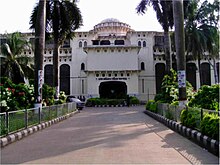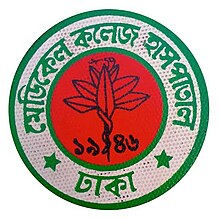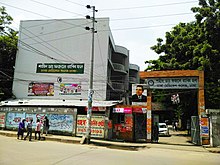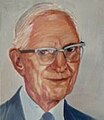Dhaka Medical College and Hospital
ঢাকা মেডিকেল কলেজ | |
Medical College & Hospital | |
| Established | 1946 |
|---|---|
Academic affiliation | University of Dhaka[1] Bangabandhu Sheikh Mujib Medical University[2] |
| Principal | Shafiqul Alam Chowdhury |
| Director |
Shahbagh, Dhaka , Bangladesh 23°43′33″N 90°23′50″E / 23.7257°N 90.3971°E |
| Campus | Urban, 85 acres (34 ha) |
| Language | English |
| Website | |
Dhaka Medical College and Hospital (DMCH) is a public medical college and hospital located in Dhaka, the capital city of Bangladesh. It houses a medical school as well as a tertiary care hospital on its campus.

History

Site during pre-college years
The college's original building was built before the Partition of Bengal of 1905. As of 1904, the building was being used as the secretariat (headquarters) of the newly formed provinces of East Bengal and Assam.
In 1921, it was turned over to the University of Dhaka, which was founded that year. A part of the huge building was used as the university's medical center, another part as the students' dormitory, and the rest as the office of the administrative wing of the Arts faculty.[5]
In 1939, the
During World War II the medical center building became an American armed forces hospital. The Americans vacated the building at the end of the war.[5][6]
Establishment of the college
In 1946, due to the
Major
Since the college did not initially have
Expansion
There was no lecture hall nor dissection gallery at first. These needs were met after the construction of new academic buildings in 1955. The college did not have any student housing. Male students were allowed to reside in the Dhaka University's student halls, but female students did not have the use of that facility.
The college and hospital premises were expanded with temporary sheds, some of which were built for outdoor services of the hospital and some for student housing. New buildings for housing, college, and hospital were constructed in phases: a dormitory for girls in 1952, a dormitory for male students in 1954–55, a new complex of academic buildings in 1955, and a dormitory for internee doctors in 1974–75.[6] A new academic and hospital building, adding 500 beds, Dhaka Medical College Hospital-2 (DMCH-2), was inaugurated by Prime Minister Sheikh Hasina on 3 October 2013.[9] The country's first ever autologous bone marrow transplant took place in its bone marrow transplant unit.[10][11]
Origin of 'K'
Every student batch, or class, of Dhaka Medical College is tagged with the prefix K along with a number. The first year, the beginning batch of the college, was named K-1, likewise second year as K-2, third year as K-3, fourth year as K-4, and fifth year K-5. In 2021, DMC is hosting its 78th batch, hence branded as K-78. Many theories about the origin of the letter K exist, the most popular being that K stands for
Though Kolkata was
Undergraduate course
A countrywide combined medical admission test for
The qualified candidates, according to their preferences, get the opportunity to study at Dhaka Medical College. Foreign candidates from both SAARC and non-SAARC countries are selected by DGHS and MOHFW as per required qualifications.[19]
The college runs 5-year MBBS course according to the curriculum developed by BMDC. A student studies Anatomy, Physiology, Biochemistry, Pathology, Pharmacology, Microbiology, Forensic Medicine, Community Medicine, Medicine & allied subjects, Surgery & allied subjects and Gynecology & Obstetrics during the course period.
The course is divided into 4 phases. Four professional examinations, one at the end of each phase, are held under University of Dhaka. After passing the fourth or final professional examination, a student is awarded with MBBS degree. Course curriculum follows percentage system grading. Pass mark for the college's internal as well as professional examinations is 60 percent. Students shall have to pass written (MCQ + SAQ + formative), oral, practical and clinical examinations separately.[20]
Postgraduate courses
College offers
College also runs three fellowship courses of Bangladesh College of Physicians and Surgeons in different disciplines.[21]
Principals
| Name | Duration in office | Ref. | |
|---|---|---|---|
| From | To | ||
| Major William John Virgin
|
1 July 1946 | 14 August 1947 | [22] |
| Lt. Col. Edward George Montgomery | 15 August 1947 | 19 April 1948 | [23] |
| T. Ahmed | 19 April 1948 | 12.31.1952 | |
| Colonel M. K. Afridi | 12.31.1952 | 20 March 1953 | [12] |
| Nawab Ali | 21 March 1953 | 10 April 1954 | |
| A. K. M. Abdul Wahed | 11 April 1954 | 20 January 1955 | |
| Nawab Ali | 21 January 1955 | 1 February 1957 | |
| Md. Refat Ullah | 1 February 1957 | 1 September 1958 | |
| Habib Uddin Ahmed | 2 September 1958 | 4 June 1959 | |
| Lt. Col. M. M. Haque | 4 June 1959 | 11 September 1963 | |
| A. K. S. Ahmed | 11 September 1963 | 28 December 1963 | |
| G. Kibria | 28 December 1963 | 8 February 1964 | |
| Lt. Col. Borhanuddin | 9 February 1964 | 27 January 1969 | |
| K. A. Khaleque | 27 January 1969 | 30 December 1970 | |
| Saifullah | 1 January 1971 | 20 May 1971 | |
M. R. Chowdhury
|
25 May 1971 | 2 July 1974 | |
| M. A. Jalil | 3 July 1974 | 6 May 1976 | |
| M. A. Kashem | 7 May 1976 | 1 October 1978 | |
| Md. Shahidullah | 2 October 1978 | 25 November 1980 | |
| Mazharul Imam | 25 November 1980 | 1 October 1981 | |
| M. A. Mazed | 1 October 1981 | 2 July 1982 | |
| M. I. Chowdhury | 2 July 1982 | 31 January 1985 | |
| Mirza Mazharul Islam | 31 January 1985 | 13 December 1986 | |
Waliullah
|
13 December 1986 | 30 January 1990 | |
M. Kabiruddin Ahmed
|
31 January 1990 | 30 March 1991 | |
| Zwahurul Moula Chaudhury | 30 March 1991 | 14 January 1995 | |
| Md. Shofiullah | 14 January 1995 | 22 January 1995 | |
| M. A. Hadi | 22 January 1995 | 18 July 1996 | |
| A. B. M. Ahsan Ullah | 18 July 1996 | 19 September 1999 | |
| A. K. Md. Shahidul Islam | 19 September 1999 | 29 August 2001 | |
| Md. Abdul Kadir Khan | 29 August 2001 | 15 November 2001 | |
| Tofayel Ahmed | 15 November 2001 | 7 August 2003 | |
| Md. Fazlul Haque | 7 August 2003 | 29 September 2003 | |
| Hosne Ara Tahmin (Charu) | 29 September 2003 | 26 June 2006 | |
| Syed Mahbubul Alam | 26 June 2006 | 1 March 2007 | |
| M. Abul Faiz | 1 March 2007 | 7 January 2008 | |
Quazi Deen Mohammad
|
17 January 2008 | 9 January 2014 | |
| Md. Ismail Khan | 9 January 2014 | 13 May 2017 | |
| Md. Shafiqul Alam Chowdhury (Acting) | 13 May 2017 | 13 June 2017 | |
| Khan Abul Kalam Azad | 13 June 2017 | 31 December 2020 | [24] |
| Md. Titu Miah | 1 January 2021 | 4 January 2023 | [25] |
| Md. Shafiqul Alam Chowdhury | 5 January 2023 | Present | [26] |
-
Major William John Virgin, First principal of DMC
-
Colonel M. K. Afridi,malariologist
-
Nawab Ali, Two times served as a principal
-
M. A. Hadi, 28th principal of DMCH
Hospital wing

Facilities and services
Dhaka Medical College has a 2600-bed[27] teaching hospital as Dhaka Medical College Hospital (DMCH) within the same compound,with 92 wards. It is a tertiary referral hospital. It has a 300-bed facility dedicated for burn & plastic surgery. It was the largest burn unit of the country until Sheikh Hasina National Institute of Burn and Plastic Surgery was set.
With over 500 admissions per day, 1300 emergency visits per day and 5000 patients at OPD per dayat the hospital, it has an occupancy rate of 133%. It also includes about 50 Operation Theatres that perform about 50,000 major operations and about 35,000 minor operations per year.
In 2015, Hospital's Out-Patient Department provided services to 799,896 patients.[27] More 346,580 patients attended at the emergency and 149,122 patients got admitted in different facilities of the hospital in 2015.[27] The surgical staffs performed 58,355 surgeries in 2015.[27] Expansion plan to turn the hospital into a 5000-bed facility has been contemplated.[28]

Country's first bone marrow transplant center was set in this hospital in October 2013 in collaboration with Massachusetts General Hospital.[29][30][31] This unit conducted first ever successful autologous bone marrow transplant in the country in March 2014.[32][33][34][35][36] The unit also introduced allogeneic bone marrow transplant on 3 July 2019, the first in the country.[37]
Clinical teaching
It is one of the major teaching hospitals in the country.[citation needed] Bedside teaching and clinical examinations of the undergraduate as well as postgraduate students take place at the hospital wing.[citation needed]
Dhaka Medical College Hospital is a recognized clinical examination centre for fellowship examination of Bangladesh College of Physicians and Surgeons.[citation needed]
Hospital administration
Director of the hospital is the administrative chief of the hospital service. Deputy director, assistant directors and other officials give him assistance in this regard. Faculties from different departments of the college act as clinical and administrative superiors of the respective department. They actively supervise the clinical services as well as clinical training of the trainee doctors.[citation needed]
Student life
Students' accommodation

In the past, Ramesh Chandra Majumdar, the then vice chancellor of University of Dhaka, arranged accommodation for the medical college students. Muslim students were accommodated in Salimullah Muslim Hall, Hindus were accommodated in the then Dhaka Hall (now Dr. Muhammad Shahidullah Hall). Baptist mission hostel at Sadarghat accommodated the Christian students. Nursing Hostel was allocated for the female students. Later, 20 medical barracks were built and students were accommodated there. As of 2019, there are four hostels for accommodation of the students as well as interns.[citation needed]
- Shaheed Dr. Fazle Rabbee Hall (established in 1955) - For male students (named after martyred intellectual Mohammed Fazle Rabbee)[citation needed]
- Dr. Alim Chowdhury Hall - For female students (named after martyred intellectual AFM Alim Chowdhury)[citation needed]
- Shaheed Dr. Shamsul Alam Khan Milon Intern Doctors' hostel (Male) (named after the martyred activist of anti-autocracy movement in 1990, Shamsul Alam Khan Milon)[citation needed]
- Shaheed Dr. Shamsul Alam Khan Milon Intern Doctors' Hostel (Female)[citation needed]
Dr. Fazle Rabbee Hall and Dr. Milon Intern Doctors' hostel (for male) share the same compound at Bakshibazar, Lalbagh, Dhaka. Dr. Alim Chowdhury hall and Dr. Milon Intern doctors' hostel (for female) share the same compound inside the territory of the college.[citation needed]
Sports facility
DMC has a sports ground inside Fazle Rabbee Hall. It is used for football, cricket, and other athletics. Fazle Rabbee Hall also houses a basketball ground and a tennis ground. Besides, college building and hostels have students' common rooms with indoor game facility[citation needed]
Cultural activities
College has an auditorium with 1200 sitting capacity.[citation needed] DMC day is celebrated each year on 10 July, the foundation day of the college.[7]
Role in national politics
Bengali Language Movement (1948-1952)
The college dormitories that were known as barracks were at the heart of the
There were about 20 tin shed barracks where the medical students resided. Because they were close to the Parliament of East Pakistan (presently Jagannath Hall of Dhaka University), the medical dormitories were chosen as the center of the student movement.[citation needed]
In the early hours of 21 February 1952, all the students of Dhaka Medical College gathered in front of the medical college dormitories. In the afternoon the group headed for the parliament which was in session. No procession was allowed due to the imposition of Section 144 (a section of the penal code that prohibited unlawful assembly). The students decided to defy Section 144 at 4:00 PM at the historic Aam-tola (which was situated beside the present day Emergency gate).[citation needed]
The police fired at the procession, resulting in the deaths of Salam, Barkat, Rafique, Jabbar and Shafiur.[38][39] After sunset on 21 February, at the site of the deaths, the students of Dhaka Medical College decided to build a monument. Badrul Alam and Sayed Haider the then students of Dhaka Medical College planned and designed the structure. They worked continuously on 22 and 23 February and finished the construction, using bricks, gravel and cement reserved for the hospital. A paper with Shaheed Smritistambha( Monument in memory of the martyrs) written on it was attached on the monument. It was inaugurated by the father of Shofiur Rahman, a martyr of language movement. However, the monument was demolished by government forces on 26 February 1952.[40][41]
Liberation War (1971)
Many staff and students took part in the 1971 Bangladesh Liberation War, as fighters or in treating the injured.[8] DMC's doctors, teachers and students laid their lives in the war. Many eminent physicians and academics were abducted from home and killed during the war.[citation needed]
Notable people
Alumni
- Rashiduddin Ahmad, neurosurgeon[42]
- Badrul Alam, activist in the Bengali language movement, designer of first Shaheed Minar, Ekushey Padak awardee (2014)[43][44]
- Independence Day Award in 2018[45]
- Syed Modasser Ali, former health advisor to Prime Minister Sheikh Hasina[8]
- M Iqbal Arslan, President of Swadhinata Chikitshak Parishad[46]
- Kanak Kanti Barua, neurosurgeon, vice-chancellor of BSMMU[47]
- Sitara Begum, doctor, army officer awarded the Bir Protik[48]
- AFM Alim Chowdhury, ophthalmologist, intellectual killed during the Bangladesh Liberation War[49]
- Independence Day Award in 2017[50]
- Independence Day Award awardee in 1993[51]
- Meerjady Sabrina Flora, epidemiologist, former Director of IEDCR[citation needed]
- Sayed Haider, activist in the Bengali language movement, designer of Shaheed Minar, Ekushey Padak awardee (2016)[52][53]
- A F M Ruhul Haque, former Health and Family Welfare Minister, orthopedic surgeon, former President of Swadhinata Chikitshak Parishad[8]
- AKM Fazlul Haque, pioneer colorectal surgeon[citation needed]
- Mirza Mazharul Islam, surgeon, language movement veteran, Ekushey Padak awardee (2018)[54]
- obstetrician/gynecologist[55]
- Independence Day Award (2004)[56]
- Shamsul Alam Khan Milon, activist killed during the 1990 Mass Uprising in Bangladesh[citation needed]
- Quazi Deen Mohammad, neurologist, Founding Director of NINS, President of Bangladesh College of Physicians and Surgeons[citation needed]
- Mostofa Jalal Mohiuddin, President of Bangladesh Medical Association, formerly President of Bangladesh Chhatra League[citation needed]
- Dipu Moni, Education Minister, former Minister of Foreign Affairs[8]
- Golam Moula, activist in the Bengali language movement, Eksushey Padak awardee (2010) (posthumous)[57][58]
- Mohammed Fazle Rabbee, cardiologist, intellectual killed during the Bangladesh Liberation War[59]
- Ahmed Rafiq, activist in the Bengali language movement, writer, researcher, Ekushey Padak awardee (1995)[60]
- Lutfor Rahman, cardiac surgeon[61]
See also
References
- ^ a b Office of the Inspector of Colleges. List of Constituent College.pdf
- ^ a b "Affiliated Institutes - BSMMU-Bangabandhu Sheikh Mujib Medical University". bsmmu.edu.bd. Retrieved 6 January 2021.
- ^ "Director".
- ^ "DMCH director changed". New Age. Retrieved 27 July 2020.
- ^ a b c পুরোনো সচিবালয়ই ঢাকা মেডিকেল কলেজ. Prothom Alo (in Bengali). Retrieved 6 January 2021.
- ^ a b "Dhaka Medical College and Hospital". Banglapedia. Retrieved 29 July 2020.
- ^ a b "DMC foundation day celebration on 10 July". The Daily Star. 7 July 2008. Retrieved 12 July 2020.
- ^ a b c d e f g Monilal Aich Litu; Abdul Hanif Tablu (19 July 2009). "Sixty Three Years of Dhaka Medical College". Star Campus. The Daily Star.
- ^ "PM inaugurates second phase of DMCH". Dhaka Tribune. 3 October 2013. Retrieved 29 July 2020.
- ^ "The bone marrow transplant: first time in Bangladesh". The Independent. 23 November 2015. Retrieved 25 June 2020.
- ^ "Bangladesh begins bone-marrow transplant". bdnews24.com. Retrieved 25 June 2020.
- ^ ISBN 1-85756-405-7.
- ^ "Bengal House passes law legalising 'Kolkata' | Kolkata News". The Times of India. Retrieved 27 July 2020.
- ^ "Why Is Calcutta Now Kolkata? What Other Names in India Are Changing?". NPR. Retrieved 27 July 2020.
- ^ "When Kolkata began as Calcutta: The history of the first capital of British India". India Today. Retrieved 27 July 2020.
- ^ "Medical Admission Circular 2024 in Bangladesh - Doctors Gang". 29 January 2024.
- ^ "Medical Admission Test Circular 2019-20। dghs.teletalk.com.bd". Admissionwar.com. 27 August 2019. Retrieved 26 July 2020.
- ^ "Lekhapora BD" মেডিকেল কলেজসমূহে এমবিবিএস কোর্সে প্রথম বর্ষে ভর্তি বিজ্ঞপ্তি ২০১৯-২০ দেখুন এখানে. lekhaporabd.com (in Bengali). 18 September 2019. Retrieved 26 July 2020.
- ^ "List of foreign students selected for admission in Government Medical Colleges". dghs.gov.bd. Retrieved 6 January 2021.
- ^ "BM&DC". Bangladesh Medical & Dental Council. Archived from the original on 29 October 2019. Retrieved 24 June 2020.
- ^ a b ঢাকা মেডিকেল কলেজ. dmc.gov.bd. Retrieved 6 January 2021.
- ^ "History of Dhaka Medical College". Dhaka Medical College. Retrieved 11 August 2020.
- ISBN 1-85756-405-7.
- ^ ঢামেকের অধ্যক্ষ হলেন অধ্যাপক ডা. খান আবুল কালাম আজাদ. medivoicebd.com (in Bengali). 8 October 2019. Retrieved 6 January 2021.
- ^ "Government appoints new principals to Dhaka, Mugda medical colleges". bdnews24.com. Retrieved 6 January 2021.
- ^ "ঢাকা মেডিকেল কলেজ".
- ^ a b c d "Local Health Bulletin- 2020". app.dghs.gov.bd. Retrieved 29 July 2020.
- ^ "DMCH will be turned into a 5,000-bed hospital". The Daily Star. 17 January 2019. Retrieved 24 June 2020.
- ^ "Country's first Bone Marrow Transplant unit opens at DMCH". Dhaka Tribune. 20 October 2013. Retrieved 25 June 2020.
- ^ "DMCH bone marrow transplant to start". bdnews24.com. Retrieved 25 June 2020.
- ^ দেশেই এবার অস্থিমজ্জা প্রতিস্থাপন. Prothom Alo (in Bengali). 17 October 2013. Retrieved 25 June 2020.
- ^ "Bone-marrow transplant in Bangladesh". bdnews24.com. Retrieved 25 June 2020.
- ^ দেশে প্রথম বোনম্যারো প্রতিস্থাপন ঢামেকে. Samakal (in Bengali). Retrieved 25 June 2020.
- ^ প্রথমবারের মতো অস্থিমজ্জা প্রতিস্থাপন বাংলাদেশে. Prothom Alo (in Bengali). 11 March 2014. Retrieved 25 June 2020.
- ^ বাংলাদেশে প্রথমবারের মতো অস্থিমজ্জা প্রতিস্থাপন. Prothom Alo (in Bengali). 10 March 2014. Retrieved 25 June 2020.
- ^ "First ever bone marrow transplant carried out in the country". Dhaka Tribune. 10 March 2014. Retrieved 25 June 2020.
- ^ "Country's first successful allogeneic bone marrow transplant at DMC". The Business Standard. 21 July 2019. Retrieved 29 July 2020.
- ^ "Martyrs of Language Movement". Daily Sun. Retrieved 7 January 2021.
- ^ "Language Movement". Banglapedia. 7 March 2016. Archived from the original on 7 March 2016. Retrieved 7 January 2021.
- ^ "It's True!". The Daily Star. 21 February 2015. Retrieved 15 July 2020.
- ^ "Shaheed Minar". Banglapedia. Retrieved 15 July 2020.
- ^ "Bangladesh's first neurosurgeon Rashiduddin Ahmad dies". bdnews24.com. 19 March 2016.
- ^ ডা. বদরুল আলম. Bhorer Kagoj (in Bengali). Archived from the original on 16 January 2020. Retrieved 11 April 2021.
- ^ একুশে পদকপ্রাপ্ত সুধীবৃন্দ (PDF). Ministry of Cultural Affairs (in Bengali). Retrieved 16 January 2020.
- ^ Rahman, Saidur (27 May 2017). "Dr. Ahsan Ali—a pioneer in TB treatment in Bangladesh". The Independent.
- ^ "Arslan made president, Aziz secy general". Banglanews24.com. 18 November 2018. Retrieved 25 June 2020.
- ^ "BSMMU gets Prof Kanak Kanti Barua as new vice-chancellor". bdnews24.com. 16 March 2018.
- ^ "The women in our Liberation War". The Daily Star. 16 December 2016. Retrieved 11 April 2021.
- ^ Reaz, Bayzid Khurshid (2012). "Chowdhury, AFM Abdul Alim". In Islam, Sirajul; Jamal, Ahmed A. (eds.). Banglapedia: National Encyclopedia of Bangladesh (Second ed.). Asiatic Society of Bangladesh.
- .
- ^ "Chowdhury, AQM Badruddoza". Banglapedia. Retrieved 11 April 2021.
- ^ চলে গেলেন ভাষাসংগ্রামী ডা. সাঈদ হায়দার. bdnews24.com (in Bengali). Retrieved 11 April 2021.
- ^ "Uphold dignity of mother tongue". The Daily Star. 21 February 2016. Retrieved 11 April 2021.
- ^ "Language Movement hero Dr Mirza Mazharul Islam dies of COVID-19". bdnews24.com. Retrieved 11 April 2021.
- ^ "National Professor Shahla Khatun". Green Life Hospital. Retrieved 16 May 2023.
- ^ ".:: About NHFB | National Heart Foundation of Bangladesh ::". www.nhf.org.bd. Retrieved 11 April 2021.
- ^ "Language martyrs honoured". bdnews24.com. Retrieved 11 April 2021.
- ^ "Golam Mowla, the Language Movement's forgotten hero". Dhaka Tribune. 19 February 2019. Retrieved 11 April 2021.
- ^ Rabbee, Nusrat. "Remembering a Martyr". The Daily Star. Archived from the original on 27 October 2013. Retrieved 11 April 2021.
- ^ একনজরে আহমদ রফিক | বাংলাদেশ প্রতিদিন. Bangladesh Pratidin (in Bengali). Retrieved 11 April 2021.
- ^ Ahmed, Hana Shams (23 June 2006). "A Life-saving Innovator". Star Weekend Magazine. The Daily Star. Archived from the original on 4 March 2016. Retrieved 1 February 2016.




